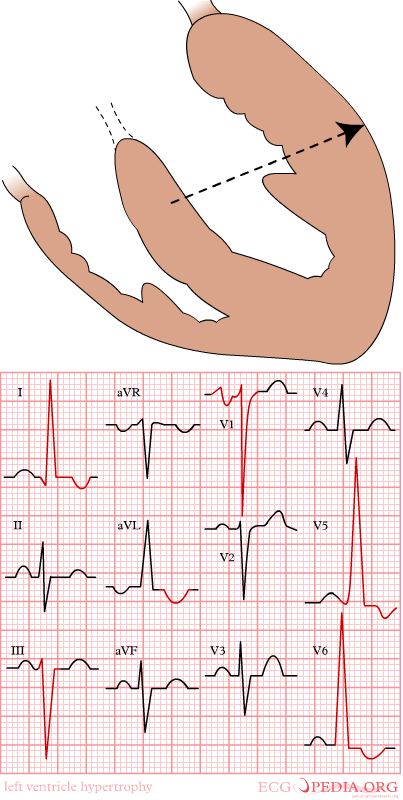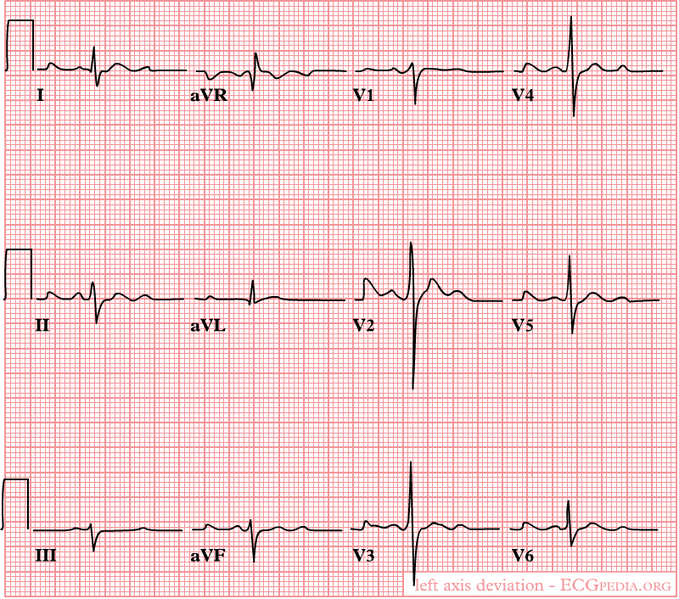Aortic regurgitation electrocardiogram: Difference between revisions
Hardik Patel (talk | contribs) |
Hardik Patel (talk | contribs) |
||
| Line 9: | Line 9: | ||
In aortic insufficiency, the electrocardiographic findings are nonspecific. However, the following may be noted: | In aortic insufficiency, the electrocardiographic findings are nonspecific. However, the following may be noted: | ||
*[[Left ventricular hypertrophy]] | *[[Left ventricular hypertrophy]] | ||
[[Image:LVH.png| | [[Image:LVH.png|left|350px|[[Left ventricular hypertrophy]]]] | ||
<br clear="left"/> | |||
Copyleft image obtained courtesy of ECGpedia,http://en.ecgpedia.org/wiki/Main_Page | |||
*[[Left axis deviation]] | *[[Left axis deviation]] | ||
[[Image:679px-LHA.png| | [[Image:679px-LHA.png|left|350px|[[Left axis deviation]]]] | ||
<br clear="left"/> | |||
Copyleft image obtained courtesy of ECGpedia,http://en.ecgpedia.org/wiki/Main_Page | |||
*[[Left atrial enlargement]] | *[[Left atrial enlargement]] | ||
*Left ventricular volume overload pattern (prominent [[Q wave]]s in leads [[Electrocardiogram|I]], [[Electrocardiogram|aVL]], and [[Electrocardiogram#Precordial|V3]] to [[Electrocardiogram#Precordial|V6]] and relatively small [[R wave]]s in [[Electrocardiogram#Precordial|V1]]) | *Left ventricular volume overload pattern (prominent [[Q wave]]s in leads [[Electrocardiogram|I]], [[Electrocardiogram|aVL]], and [[Electrocardiogram#Precordial|V3]] to [[Electrocardiogram#Precordial|V6]] and relatively small [[R wave]]s in [[Electrocardiogram#Precordial|V1]]) | ||
Revision as of 19:10, 29 January 2013
|
Aortic Regurgitation Microchapters |
|
Diagnosis |
|---|
|
Treatment |
|
Acute Aortic regurgitation |
|
Chronic Aortic regurgitation |
|
Special Scenarios |
|
Case Studies |
|
Aortic regurgitation electrocardiogram On the Web |
|
American Roentgen Ray Society Images of Aortic regurgitation electrocardiogram |
|
Risk calculators and risk factors for Aortic regurgitation electrocardiogram |
Editor-In-Chief: C. Michael Gibson, M.S., M.D. [1]; Associate Editor(s)-in-Chief: Cafer Zorkun, M.D., Ph.D. [2]; Varun Kumar, M.B.B.S.; Lakshmi Gopalakrishnan, M.B.B.S.
Overview
Electrocardiographic abnormalities in the patient with aortic insufficiency include left ventricular hypertrophy and left axis deviation.
Electrocardiogram
In aortic insufficiency, the electrocardiographic findings are nonspecific. However, the following may be noted:

Copyleft image obtained courtesy of ECGpedia,http://en.ecgpedia.org/wiki/Main_Page

Copyleft image obtained courtesy of ECGpedia,http://en.ecgpedia.org/wiki/Main_Page
- Left atrial enlargement
- Left ventricular volume overload pattern (prominent Q waves in leads I, aVL, and V3 to V6 and relatively small R waves in V1)
- Left ventricular conduction defects (typically late in the disease process)
- Re-polarization abnormalities
- ST-segment depression in precordial leads.